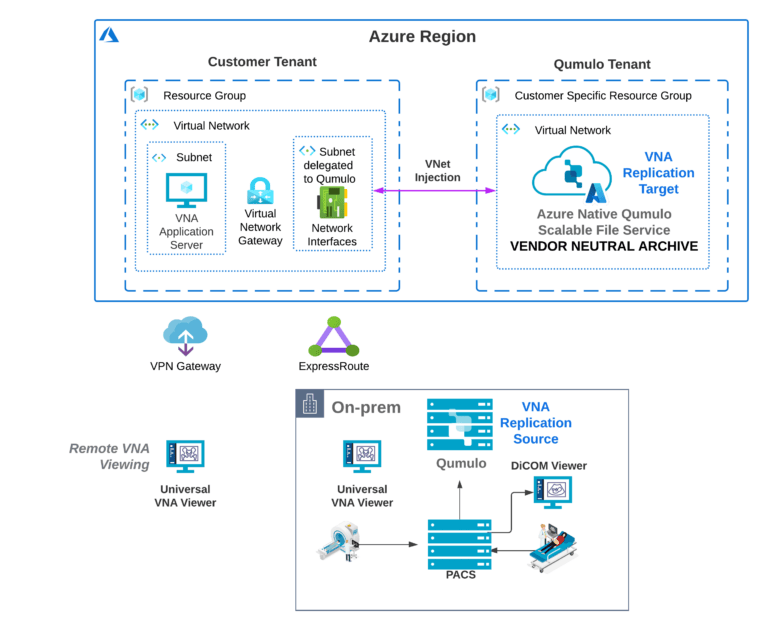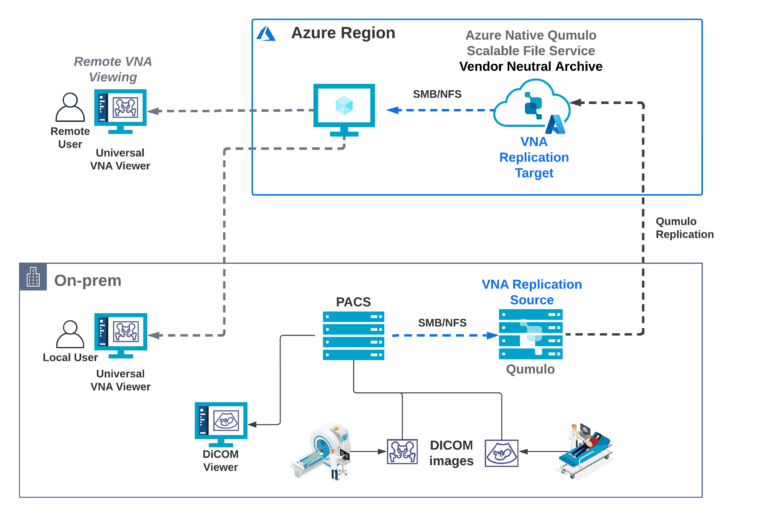Table of Contents
- Solution Architectures
- Workflow – Data Replication and Client Access
- Components
- Potential use cases
- Scalability and Performance
- Security
Deploy this Scenario
Contributors
Next steps
Related Resources
Azure Native Qumulo Reference Architecture – Vendor-Neutral Archive for PACS
A Vendor-Neutral Archive (VNA) provides a means for healthcare providers to store, use, and archive medical images and other data from one or more vendor-specific PACS (Picture Archiving and Communication Systems) platforms. Whereas PACS data can be proprietary by vendor and inaccessible to outside applications, VNAs offer a standardized data format and interface regardless of which vendor or system originated the data.
This article describes a solution for deploying a VNA solution that encompasses one or more on-premises locations in conjunction with an Azure Native Qumulo Scalable File Service deployment to serve as an archive target for long-term retention of VNA images and data.
Architecture
The solution is deployed across one or more on-premises locations, using an instance of Azure Native Qumulo Scalable File Service (ANQ) as an archive repository.
Solution Architecture

Download a Visio file of this architecture.
Within each site, the healthcare provider’s PACS solution is configured to use a local Qumulo cluster for VNA storage. The Qumulo cluster is configured to replicate VNA data to the ANQ archive target. In this solution, a VNA Application server has been deployed in the customer’s Azure tenant and connected via SMB/NFS to the ANQ archive cluster.
Workflow – Data Replication and Client Access

Download a Visio file of this architecture.
With this setup, access to the VNA archive repository can be enabled from anywhere via any Universal VNA Viewer application. These can be deployed on-prem for access by onsite viewers/users, and/or via cloud platform for access by remote viewers/users.
In this solution access to data within the VNA archive repository is through a VNA Application Server in the customer’s own Azure tenant.
Components
- On-premises Qumulo cluster to serve as a local VNA repository
- Azure Native Qumulo Scalable File Service deployment to provide consolidated, cloud-based VNA archive services
- Azure ExpressRoute and/or Azure VPN Gateway
- Azure Virtual Network
- VNet Injection
- One-way replication enabled between the on-premises Qumulo cluster(s) and the target ANQ cluster on Azure
- On-premises PACS application environment(s), configured to export VNA formatted data to the local Qumulo cluster
- On-premises and/or cloud-based Universal VNA Viewer(s), configured to use Azure-based VNA Application Server for accessing VNA archive data.
Solution Benefits
While a VNA solution can also be deployed on-prem, a cloud-based solution, backed by ANQ, offers a number of advantages, including unlimited scalability, simpler cross collaboration between multiple organizations and / or institutions, and a more cost-effective solution in many cases than a data-center or private-cloud based deployment.
Potential Use Cases
This architecture applies to healthcare providers and other healthcare organizations whose PACS data needs to be accessible beyond the originating PACS application.
Potential use cases:
- Healthcare providers that use multiple imaging applications but use a standardized imagery format to improve clinical workflows and continuity of care between different systems.
- Healthcare and life-sciences organizations that conduct research or analysis using medical imagery from multiple sources, whether for short-term or long-term studies.
- Healthcare and life-science organizations that share documents and imagery with outside providers and organizations.
Considerations
Enterprises planning a VNA archive solution using Qumulo on-prem and Azure Native Qumulo Scalable File Service should include the following considerations in their planning and design processes.
Scalability and Performance
Enterprise architects and other stakeholders should ensure that their solution addresses the following scalability and performance factors:
- Capacity and growth – while a Qumulo cluster can easily be expanded to add capacity as needed, the on-prem cluster should be sized with sufficient capacity to support 3-6 months’ of data intake and retention for both the PACS and VNA datasets.
- Performance and throughput
- The on-premises Qumulo cluster(s) should be configured to support the intake of data from the PACS application(s) while simultaneously replicating VNA data to the ANQ target
- The ANQ cluster should be able to receive incoming replication traffic from the solution’s on-prem Qumulo cluster(s) while concurrently supporting all data requests from the customer’s VNA Application Server.
Security
While Azure Native Qumulo is fully HIPAA compliant, customers are still responsible for planning, implementing and maintaining the security of the solution to satisfy all applicable legal and regulatory requirements for their industry and location.
Deploy this scenario
- For a guide to deploying ANQ, see Getting Started with the Azure Native Qumulo Scalable File Service and Deployment.
- For more information regarding inbound and outbound networking, see Required Networking Ports for Qumulo Core.
For detailed instructions on configuring and managing replication between the on-premises Qumulo cluster and the ANQ target, see Replication: Continuous Replication with 2.11.2 and above.
Contributors
Next steps
Related resources
Azure Native Qumulo Scalable File Service (Marketplace)
Azure Native Qumulo Scalable File Service
Azure Native Qumulo Scalable File Service Guide
Qumulo Continuous Replication
Qumulo Snapshot Policy Replication
Using Failover with Replication in Qumulo
QumuloSync
Part I: Accelerate Data Recovery With Qumulo
Part II: Accelerate Data Recovery With Qumulo
Why Your Enterprise Infrastructure Should Innovate at the Speed of SaaS
Building a Hybrid Cloud File System for Radical Simplicity
